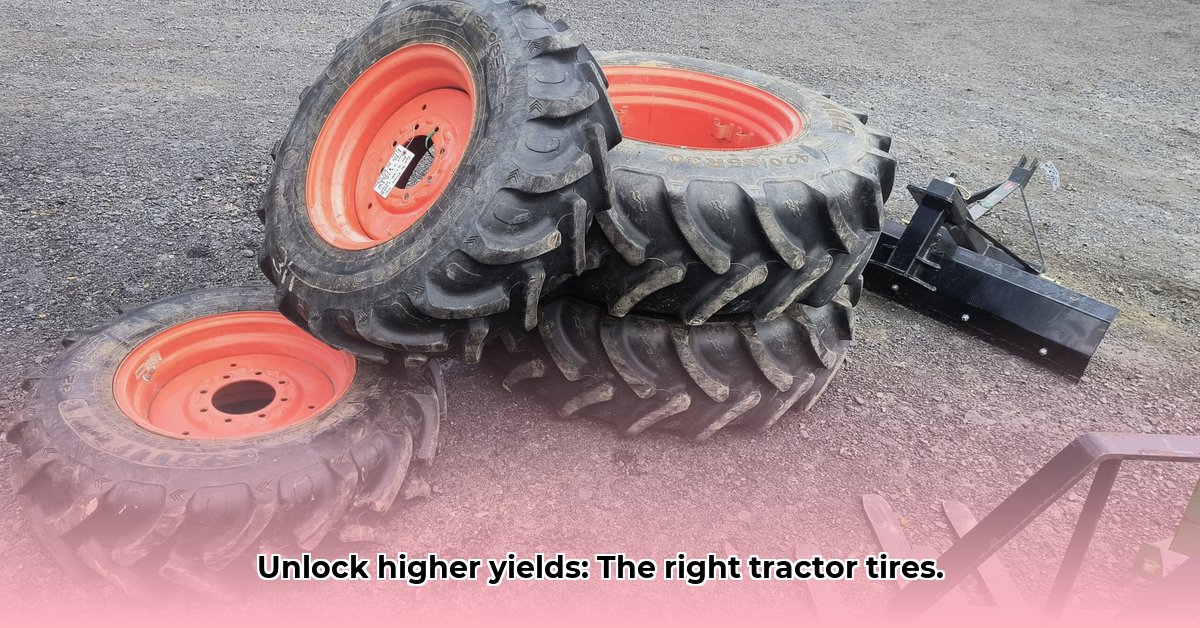
Choosing the right 16.9 x 30 tractor tires is crucial for farm efficiency, sustainability, and ultimately, higher yields. This guide helps you navigate the selection process, ensuring you choose tires perfectly suited to your specific needs and operating conditions. For more tire options, check out these other tire sizes.
Understanding Your Farming Operation: A Foundation for Success
Before examining tire specifications, a thorough assessment of your farm’s unique characteristics is paramount. What are the prevalent soil types on your land? Are they sandy, rocky, clayey, or consistently muddy? Soil compaction risk and moisture content significantly impact tire selection. A farmer working predominantly in rocky terrain will require a far different tire than one tilling consistently muddy fields.
What tasks does your tractor perform regularly? Plowing, planting, or harvesting place distinct demands on tire performance and durability. Heavy-duty operations necessitate tires with superior load capacity and robust construction, whereas lighter tasks may allow for slightly less robust options.
Don't forget your tractor's specifications! The size, weight, and horsepower of your tractor dictate the appropriate tire size and load rating. Consult your tractor’s manual for recommended tire specifications and maximum load capacities to ensure compliance and prevent damage.
Decoding the 16.9 x 30 Code: Understanding Tire Dimensions and Specifications
The designation "16.9 x 30" specifies the tire's dimensions: 16.9 inches represents the tire's section width, while 30 inches refers to the wheel diameter. However, this is just the starting point; several other critical factors determine tire suitability.
Ply Rating: This indicates the tire's strength and load-bearing capacity. Higher ply ratings denote greater durability and the ability to withstand heavier loads. Think of it like the tire's structural integrity; a higher ply rating means a more robust and resilient tire.
Tread Pattern: Tread patterns significantly influence traction and soil compaction. Aggressive, deep treads provide exceptional grip in challenging conditions like mud or snow, essential for robust fieldwork. Conversely, shallower treads minimize soil compaction, crucial for preserving soil health, reducing fuel consumption, and obtaining optimal yields. The choice depends on your soil type and farming practices. Deep treads provide excellent traction in mud, but may increase compaction. Shallower treads offer reduced compaction but potentially compromise traction on difficult terrain.
Choosing a Tire Brand: A Focus on Quality and Performance
Comprehensive brand-by-brand comparisons are difficult without extensive testing data. Instead, focus on these key aspects:
- Reputation: Prioritize brands known for their quality, durability, and reliability within the agricultural community. Word-of-mouth from fellow farmers can be highly informative.
- Warranty: A robust manufacturer warranty underscores confidence in their product's longevity.
- Customer Reviews: Online reviews provide valuable insights into real-world performance and longevity. Look for consistent, positive feedback on tire wear, traction, and overall satisfaction.
- Dealer Recommendations: Your equipment dealer offers valuable expertise, often possessing in-depth knowledge of which brands perform optimally in your specific geographic area and soil conditions.
A Step-by-Step Guide to Selecting the Right Tires: A Practical Approach
Selecting the right tires for your tractor is a strategic process. Follow these steps for optimal results:
- Assess Your Farm: Carefully analyze your soil conditions, typical terrain, and the primary tasks performed by your tractor.
- Consult Your Tractor Manual: Your tractor's manual provides crucial information regarding recommended tire sizes and maximum load capacities. Adherence to these guidelines is vital for safety and optimal performance.
- Research and Compare: Research different tire brands and models that meet your needs, paying close attention to ply ratings, tread patterns, and customer reviews.
- Consider Long-Term Costs: While initial price is a factor, consider a tire's lifespan and potential fuel savings. A more expensive tire with substantially greater longevity might ultimately prove more cost-effective.
- Seek Expert Advice: Don't hesitate to consult with experienced agricultural mechanics or tire specialists. These experts offer invaluable guidance tailored to your specific needs and circumstances.
Tire Maintenance: A Key to Maximizing Lifespan and Performance
Proactive tire maintenance extends their lifespan, improves performance, and contributes to overall farm sustainability.
- Regular Inflation Checks: Maintain proper inflation pressures. Underinflation significantly increases wear, fuel consumption, and risk of damage. Overinflation, conversely, can lead to premature tire failure. Adhere strictly to the manufacturer's recommended inflation pressures.
- Visual Inspections: Regularly inspect tires for damage – cuts, embedded objects, or uneven wear. Address any problems promptly to prevent further deterioration.
- Proper Storage: When not in use, store tires appropriately, shielding them from direct sunlight, extreme temperatures, and potential damage.
Prioritizing Sustainability: Environmental Considerations
Sustainable farming considers the entire lifecycle of equipment. Choosing durable tires with a long lifespan dramatically reduces waste and minimizes the environmental impact associated with tire manufacturing and disposal. Furthermore, tires with lower rolling resistance significantly reduce fuel consumption, thereby decreasing greenhouse gas emissions.
Resources for Further Information
Consult your local agricultural equipment dealer for personalized advice. Major tire manufacturers provide detailed specifications and product information on their websites. Stay informed about the latest advancements in agricultural technology to ensure optimal tire selection and performance.